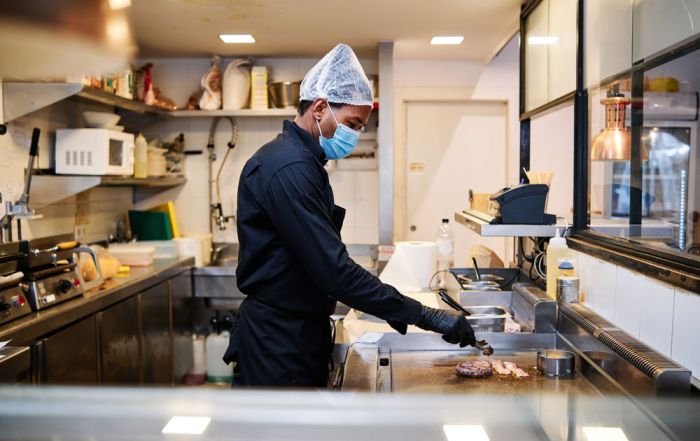Your Guide to Approved Food Safety Training Programs in 2025
Early in my foodservice career, I persuaded the owners of the restaurants I managed to train all our production employees in food safety. Knowing that the cost, both in terms of training materials and employee hours in training would be substantial, I tried to minimize the cost by becoming a certified instructor of the course I wanted to offer and teaching it to our employees myself. Little did I know at the time that my experience doing this would shape my career for the next few decades.
I knew that both our employees and management had areas where we could strengthen our food safety practices. We weren’t doing poorly, but there was room for improvement. Today, research and scientific studies show training alone doesn’t necessarily lead to better on-the-job food safety behavior. However, we also know that knowledge is essential. Before employees can improve their behavior, they must first understand the proper food safety procedures required in our operations. Training isn’t the finish line, it’s the foundation of a strong food safety culture.
Following proper food safety isn’t just a checkbox, it’s a fundamental responsibility for anyone in the foodservice industry. The 2022 FDA Model Food Code, Section 2-102.11, mandates knowledge requirements for the person in charge of food establishments. This requirement can be satisfied through three methods: maintaining a record with no priority violations during inspections, being a certified food protection manager who has passed an accredited program exam, or successfully responding to inspector questions about identified food safety topics.
While you don’t need to have every employee trained in food safety, I’ve always believed in going beyond the minimum. If my business were ever the source of a foodborne illness outbreak, I would want to know that I had done everything in my power to protect my guests. While I am no lawyer, I certainly wouldn’t want my lack of training among employees to be a fact that is ever presented to a jury in a food safety lawsuit. Training the employees who work on the front lines is the very least we can do. After all, it only takes one mistake, one employee, one bad day for a foodborne illness outbreak to occur.
With the proliferation of online training available in all facets of industry, it is important that you select a food safety program that is an approved course. Any program selected should be accredited by the American National Standards Institute National Accreditation Board in partnership with the Conference for Food Protection. This accreditation ensures the certification program meets rigorous national standards for food safety and public health. This accreditation program emerged in 2002 as the only program of its kind in the United States and has received letters of commendation from both the U.S. Department of Health and Human Services and the Centers for Disease Control and Prevention.
……training isn’t the finish line, it’s the foundation of a strong food safety culture……
As of 2025, 12 organizations offer American National Standards Institute-accredited food protection manager certification exams, two more than when I last compiled this list back in 2023. Here are the providers currently available:
- AAA Food Handler (AAA Trainers Inc.)
- Always Food Safe Company
- Certus/StateFoodSafety
- DSBWorldWide, Inc. (EduClasses)
- Learn2Serve (360training.com)
- My Food Service License
- National Registry of Food Safety Professionals (NRFSP)
- National Restaurant Association Solutions (ServSafe)
- Responsible Training (Safeway Certifications, LLC)
- Relish Works, Inc (Trust20)
- Userve
- World Food Safety Organization
Each of these programs is fully accredited and accepted in most jurisdictions that mandate food protection manager certification. However, it’s important that you verify with your local health department that they recognize your chosen certification before making a purchase, as some counties or cities may have specific preferences.
When selecting a food safety training program, there are several factors to consider. First and foremost is the format of the training. Most programs now offer 100% online training and remote-proctored exams, making certification more accessible than ever. Some also provide in-person options through testing centers. Online courses typically allow you to start and stop at your convenience, fitting training around the busy schedule of our employees.
Prices can vary significantly among providers, ranging from approximately $50 to $150 for the complete package (training plus exam). Be aware that some providers advertise low prices but add proctor fees at checkout, or perhaps don’t include proctor fees leaving you to pay additional costs when it comes time to take the exam, while others include all costs upfront. Training-only and exam-only options are also available for those who already have preparation materials or previous training.
It is important to remember that not everyone who completes the training and sits for the exam will pass on the first try. Thus, another pricing consideration is how many times the examinees may retest and how much that retest costs. Some programs allow a second retest for free; some sell different levels of test packages that include a second retest, while others charge for each additional retest.
Consider how individual employees learn best and which language they prefer. Some programs offer extensive video content, while others focus on text-based learning with practice tests. Most provide study guides, glossaries, and full-length practice exams you can take multiple times before your official certification exam. Several of the programs are now offered in multiple languages as well but be sure to investigate this before you make the purchase.
I cannot tell you which program is definitively “the best”, because that depends entirely on how you learn, how you prefer to take the exam, and your budget. What I can tell you is that all ANSI-accredited programs meet the same rigorous standards. Look into each option, compare their offerings, and use your best judgment.
Remember, protecting your guests from foodborne illness isn’t just about compliance, it’s about professional pride and responsibility. Whichever program you choose, you’re taking an important step toward ensuring the safety of everyone who trusts you with their food.
Have you had experiences with any of these training programs and exams that you’d like to share? Drop me a note at foodsafety@foodhandler.com. I’d love to hear about your experiences and may be able to use them in a future blog. Risk Nothing.
READ MORE POSTS
Hot off the Press: The 2022 Model Food Code has been Released! Part One.
It has finally arrived! Yes, the new year has arrived – but I was not referring to it. I was referring to the new 2022 Model Food Code (10th edition) that has been released by the Food and Drug Administration. I thought I might take this blog and the next blog to discuss some of the changes that have been made to the Food Code that you might see coming your way in the next few years.
Is a Food Safety Culture on your New Year’s Resolutions List?
We hope you all had a wonderful Holiday season and are getting ready for a great new year!
Don’t Underestimate the Importance of Employee Health as we head into the Winter Months
Early this month, I ran across an article discussing an outbreak investigation in the Australian Capital Territory. The outbreak caused more than 200 people to fall ill and was one of the most widespread outbreak investigations in the history of the territory. The cause was traced back to Norovirus, a virus I am sure you have heard us opine about in this blog before.
Exclusion and Restrictions: Understanding Employee Health and the Food Code
I received a call earlier in the month from a foodservice operator who suspected that one of their employees may have fallen ill and wondered if they had to send the employee home for the day. Once I started to ask a few more questions, it became obvious that the operator wasn’t really in-tune with the food code requirements on restrictions or exclusions for employees who may not be feeling well. Given that most operations are dealing with staff shortages currently and the fact that we are about to head into the fall and winter – when we tend to see an increase in upper respiratory and other illnesses, such as the flu - it seemed like a very timely and important topic for the blog this month.










